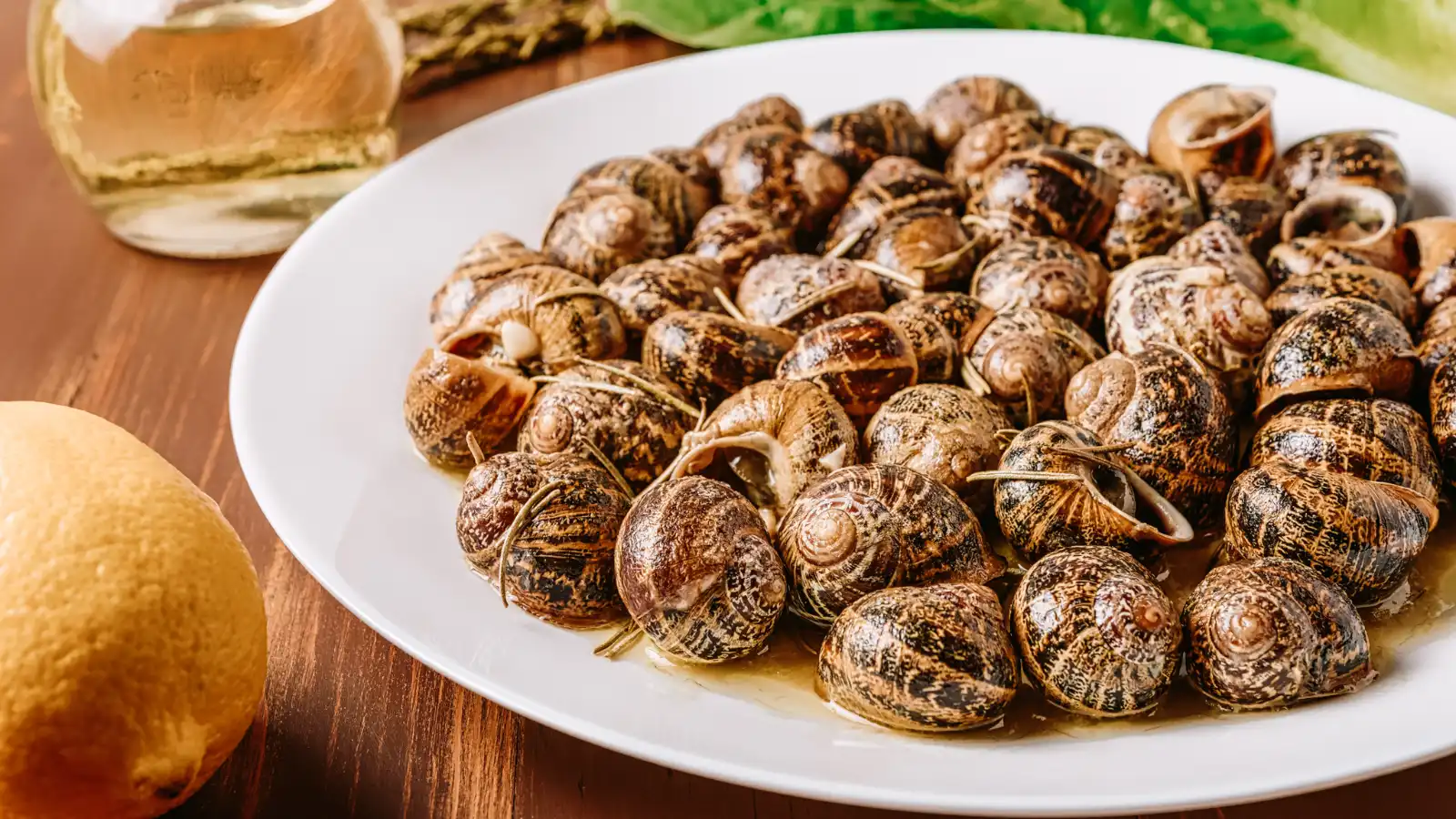12 Weird Foods in Greece
All recommendations on World Wild Schooling are independently selected by our editors. We may earn an affiliate commission from purchases made through our links.
Sure, Greece might be most known for its ancient history, stunning landscapes, and vibrant culture but beyond its sun-soaked beaches and UNESCO World Heritage sites lies a culinary world that, at times, is downright weird. But weird is wonderful, right?
While dishes like moussaka and baklava have earned global fame, there’s a whole category of Greek foods that might raise an eyebrow or two. From sea creatures to offal delicacies, Greece offers a range of peculiar edibles that challenge the conventional palate.
These culinary curiosities are not just about shock value; they’re a testament to the country’s rich gastronomic heritage and its willingness to embrace the unusual. Whether you’re an adventurous eater or simply curious about the stranger side of Greek cuisine, this list will take you on a culinary journey like no other.
Swipe and Vote: See What Travelers Recommend
Which Greek delicacy would you dare to try first? Forget Pastéis de Nata—these are weirder!
This is a swiper quiz, swipe right for yes, swipe left for no.
 © Athina Psoma / Shutterstock
© Athina Psoma / Shutterstock
 © Natalia Bratslavsky / Adobe Stock
© Natalia Bratslavsky / Adobe Stock
 © Marugod83 / Adobe Stock
© Marugod83 / Adobe Stock
 © Kristine Soghomonyan / Adobe Stock
© Kristine Soghomonyan / Adobe Stock
 © Paopano / Adobe Stock
© Paopano / Adobe Stock
Results
 1
1
 2
2
 3
3
 4
4
 5
5
1. Kokoretsi

Kokoretsi might be the most visually striking dish on this list. Imagine a spit-roasted concoction of lamb or goat intestines wrapped around seasoned offal, including liver, heart, lungs, and sometimes even sweetbreads. While the thought might make some squeamish, kokoretsi is a beloved Easter delicacy in Greece – imagine swapping chocolate Easter eggs for lamb intestine!
Kokoretsi’s origins trace back to ancient times when resourceful cooks utilized every part of the animal. Today, it’s often served during festive occasions, sliced and enjoyed with bread and a squeeze of lemon. You can find kokoretsi at traditional tavernas and street food stalls, especially during the Easter season. The smoky aroma and sizzling sounds of kokoretsi roasting on a spit are hard to resist, even for the less adventurous eater.
Read also: The Best Traditional Greek Foods To Try
2. Achinosalata (Sea Urchin Salad)

Sea urchins, known as “achinos” in Greek, are spiky sea creatures that might seem more suited to an aquarium than a dinner plate. However, in Greece, the vibrant orange roe hidden within their spiny shells is considered a delicacy. Achinosalata, or sea urchin salad, is a simple yet luxurious dish that showcases the distinctive flavor of this marine treasure.
The roe is carefully scooped out, mixed with olive oil, lemon juice, and sometimes chopped onions or herbs. The resulting salad has a creamy texture and a delicate, slightly sweet and briny flavor. Achinosalata is often served as a meze, a small appetizer meant to be shared. It’s a true taste of the sea, perfect for those who appreciate the subtle nuances of seafood. While available year-round, sea urchins are at their best during the winter months.
Read also: Delectable Dishes on the Greek Islands
3. Kohli Bourbouristi (Snails)

Snails might be a familiar delicacy in French cuisine, but in Greece, they take on a strange, somewhat cruel twist. Kohli bourbouristi, or fried snails, are a Cretan specialty that’s not for the faint of heart. The snails are cooked alive in a sizzling pan with olive oil, vinegar, and rosemary, causing them to pop and sizzle as they cook.
The result is a crispy, salty snack that’s often enjoyed with a glass of raki, a local spirit. Kohli bourbouristi is a testament to the Cretan ‘waste not, want not’ mentality, making sure to use ingredients that might be overlooked elsewhere. While the popping sound and the sight of snails in their shells might be off-putting to some, those who dare to try them are rewarded with a surprisingly flavorful and addictive treat.
Read also: Weird Foods To Try When in France
4. Splinantero

Splinantero, a type of sausage from the Thessaly region, is not for the squeamish. This rustic delicacy is made from lamb or goat spleen, heart, lungs, and sometimes other offal, all minced and seasoned with herbs and spices. The mixture is then encased in the animal’s stomach lining and grilled or baked – yum.
Splinantero has a strong, earthy flavor that’s not for everyone. However, it’s a beloved tradition in Thessaly, often once again served during festive occasions and celebrations. The sausage is typically sliced and enjoyed with bread, a drizzle of olive oil, and a shot of tsipouro, a local pomace brandy. While splinantero might not be the most visually appealing dish, its bold flavors and cultural significance make it a unique culinary experience.
Read also: Local Dishes To Try When Visiting France
5. Patsas

Patsas, a hearty tripe soup, is a classic example of Greek “comfort food” with a twist. Made from the cleaned and boiled stomach lining of a cow or lamb, patsas is simmered for hours with garlic, onions, and spices. It is certainly not the tastiest looking dish but patsas is renowned for its restorative properties.
Often consumed in the wee hours after a night of heavy drinking, patsas is believed to be a potent hangover cure. Its rich broth and warming spices are said to soothe the stomach and replenish electrolytes. You can find patsas served at traditional tavernas and specialized “patsatzidika” throughout Greece, usually late at night or early in the morning. Whether you’re seeking a remedy for a night out or simply curious about this unusual soup, this weird dish is well worth a try.
Read also: Quirky Italian Foods To Try When in Italy
6. Tzigerosarmas

Tzigerosarmas, also known as “Gypsy cabbage rolls,” is a lesser-known delicacy found in some regions of Greece. Unlike traditional dolmades, which are typically filled with rice and herbs, tzigerosarmas feature a more unconventional filling: minced lamb or goat lungs. The lungs are seasoned with spices and then wrapped in cabbage leaves before being simmered in a tomato-based sauce.
While the idea of eating lungs might be off-putting to some, tzigerosarmas offer a peculiarly delicate flavor and a unique texture. The cabbage leaves provide a subtle sweetness that balances the richness of the lung filling. Tzigerosarmas are not as widely available as other dishes on this list, but they can be found at some traditional tavernas, particularly in regions with a strong nomadic heritage.
Save this
Read also: Spectacular Local Dishes To Try When Visiting Italy
7. Kagianas

Kagianas, a scrambled egg dish, might not sound particularly weird at first glance. However, the addition of a specific ingredient takes it to a more unusual status: avgotaraho, or cured mullet roe. Avgotaraho is a prized delicacy in Greece, often compared to bottarga or caviar. It has a salty, umami flavor and a slightly grainy texture.
In kagianas, the avgotaraho is grated or crumbled over the scrambled eggs, adding a burst of flavor and a touch of luxury. This dish is typically enjoyed as a meze or a light breakfast. The combination of creamy eggs and salty, pungent roe creates a taste sensation that is equal measures odd and satisfying. While avgotaraho can be expensive, it’s worth seeking out to experience this unusual twist on a classic breakfast dish.
Read also: Awesome Dishes From Spain
8. Lamb’s Head

Arni kefali, or roasted lamb’s head, is a dish that might make some diners squeamish. However, in Greece, it’s considered a delicacy, especially in some rural areas. The head is often split in half and roasted over an open flame or in an oven, resulting in tender meat and crispy skin.
The most adventurous eaters will savor the cheeks, tongue, and even the eyes, each offering a different taste and texture. While the visual aspect of this dish might be off-putting to some, the flavors are surprisingly mild and savory.
Read also: Excellent Portuguese Foods You’d Never Forget
9. Horta

OK, so compared to lamb’s head, this dish isn’t quite as weird, but the sheer variety and unique preparation method required to make it are pretty out there. Horta in Greece includes a wide range of edible wild plants including dandelion greens, wild fennel, purslane, and many others.
First, these plants need to be foraged, usually by Greek elders with their wicker baskets plucking away at local fields in small Greek towns. After the right ingredients have been found, the greens are typically boiled or steamed before being dressed with olive oil and lemon juice. The flavor profile varies depending on the type of greens used, ranging from slightly bitter to tangy and peppery.
Read also: Amazing Street Foods To Try in Europe Cities
10. Smoked Eel

Smoked eel, or “cheli,” is a delicacy found in some regions of Greece, particularly near coastal areas and lakes. The eel is first gutted and cleaned, then smoked over wood chips, resulting in a tender, smoky fish with a slightly sweet flavor.
Smoked eel is often served as a meze, sliced thinly, and drizzled with olive oil and lemon juice. It can also be incorporated into salads or other dishes. The smoky flavor and distinctive texture of eel make it a memorable culinary experience.
Read also: Fantastic Street Food Scenes in Europe
11. Chtapodi Xidato (Marinated Octopus)

Of all the sea creatures commonly eaten, octopus might be the one that most people struggle with. The almost alien-like creatures are highly smart, with hundreds of millions of neurons that help them to solve puzzles, escape mazes, and maybe even dream.
Chtapodi xidato, also known simply as marinated octopus, is a Greek dish that is traditionally massaged and rubbed with salt to break down its tough muscle fibers. This is sometimes done by tumbling the octopus in a container full of coarse salt. It is then marinated in a mixture of vinegar, olive oil, and spices, creating a tangy and slightly chewy culinary experience.
Read also: Ultimate Gastronomic Destinations in Europe
12. Fouskes (Sea Squirts)

If ‘sea squirts’ don’t get your stomach rumbling, we don’t know what will. Known as fouskes, it is a unique seafood delicacy found along the Greek coastline. These gelatinous creatures resemble miniature sacs and are often found clinging to rocks or piers. While their appearance might not be particularly appetizing, their flavor is actually quite complex.
Fouskes have a slightly chewy texture and a delicate, briny taste with hints of iodine and sweetness. They are typically eaten raw, often drizzled with lemon juice or olive oil. While not as widely available as other seafood dishes, fouskes can be found on Greek islands such as Kalymnos.
Read also: The Best European Cities for Food Tours
Pin It Now, Read It Later











